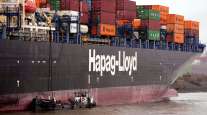The World’s Shipping Companies Are Going Super-Sized

The hulking container ships that transport sneakers, bananas and Barbie dolls around the world keep getting bigger. So are the companies that own them.
A massive consolidation is underway in the $500 billion global industry and the survivors now enjoy big economies of scale and increased demand, one year after excess capacity caused the sector’s worst-ever crisis — the bankruptcy of South Korea’s Hanjin Shipping Co.
Asia’s largest container line, China’s Cosco Shipping Holdings Co., last month said it would pay more than $6 billion for rival Orient Overseas International Ltd., owner of the world’s biggest vessel — a carrier longer than the Empire State building. Denmark’s A.P. Moller-Maersk A/S is in the process of buying a German competitor and boasts its own fleet of mega ships, including one that can carry about 180 million iPads.
These super-sized shipping companies wield much more pricing power over manufacturers and retailers like Wal-Mart Stores Inc. and Target Corp. The five biggest container lines control about 60% of the global market, according to data provider Alphaliner. Shipping rates are climbing, and an index tracking cargo rates on major routes from Asia is about 22% higher than it was a year earlier.
“Container shipping is now a game only for big boys with deep pockets,” said Corrine Png, CEO at Crucial Perspective, a Singapore-based transportation research firm. The rising market concentration will “give the liners greater pricing and bargaining power,” she predicts.
Hanjin’s collapse, in August last year, upended the industry in much the same way that the bankruptcy of Lehman Brothers roiled the financial sector during the 2008 crisis. One of the world’s largest shipping firms at the time, Hanjin faced a cash crunch as supply outstripped demand in the industry, weakening pricing power and profits for carriers. It is now in the process of being liquidated after a South Korean court declared it bankrupt in February.
“Since the demise of Hanjin Shipping, flight to quality has become more noticeable in the container shipping business,” said Um Kyung-a, an analyst at Shinyoung Securities Co. in Seoul. “That’s why the market is becoming more and more dominated by top players with big ships and those that don’t have could become more and more obsolete.”
The growing use of mammoth ships is key to the turnaround. Companies who own them are able to deploy fewer vessels and move more cargo on a single journey to benefit from higher rates, said Um.
By her estimates, there are now about 58 of these huge carriers worldwide that can transport more than 18,000 containers, and the number is expected to double in two years. About half the new vessels will be added by the biggest firms.
Higher Demand
The excess supply that derailed growth last year hasn’t completely disappeared as new entrants expand and as older vessels still remain. Capacity in the container shipping industry is expected to grow 3.4% this year and 3.6% in 2018, according to Crucial Perspective.
Still, recovery in demand seems to be on track. After posting losses in 2016, companies are seeing signs of business picking up. A.P. Moller-Maersk, which owns the world’s biggest container shipping business, said in May that it has seen strong demand toward the end of the first quarter. Cosco said earlier this month that as conditions improve it expects to report a first-half profit of about 1.85 billion yuan ($276 million), compared with a loss a year ago.
“We forecast global demand growth to outpace supply growth in 2017-2019,” Hong Kong-based analyst Andrew Lee at Jefferies Group said in a note in July.
Holiday Season
Earlier this year, Maersk, South Korea’s Hyundai Merchant Marine Co. and other shipping lines reached agreements with their customers to raise annual rates from May for cargo headed from Asia to U.S. stores like Wal-Mart and Target. Retailers in the U.S. usually increase inventory during the third quarter, ahead of the year-end holidays, and Lee said freight rates are expected to rise further as the peak season for the container shipping industry kicks off.
For retailers, “if container costs go higher, obviously it’s a headwind,” said Brian Yarbrough, an analyst at Edward Jones. “Retailers have three choices: They can pass that through to the customer or find efficiencies to offset that within the organization, or they come out and say gross margins will be pressured due to higher freight costs.”




